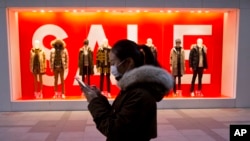China’s economic growth ticked up in the final quarter of 2016, but its full-year performance was the weakest in three decades as it heads into a potential trade battle with U.S. President-elect Donald Trump.
Trump, who takes office Friday, has promised to hike duties on Chinese goods, putting pressure on industries that employ millions of workers.
Supported by government spending and a real estate boom, the world’s second-largest economy expanded by 6.8 percent over a year earlier in the three months ending in December, up from the previous quarter’s 6.7 percent, government data showed Friday. Full-year growth was 6.7 percent, down from 2015’s 6.9 percent and the weakest since 1990’s 3.9 percent.
“A touch faster growth than expected, but no real change in trend,” Bill Adams of PNC Financial Services Group said in a report.
Cooling economy
China’s economy has cooled steadily as communist leaders try to nurture domestic consumption and reduce reliance on trade and investment, but trade still supports millions of jobs. Government spending and a surge in real estate sales last year helped offset a 7.7 percent plunge in exports, but analysts expect the economy to cool further.
“We do not expect this rebound to extend far into 2017,” Tom Rafferty of the Economist Intelligence Group said in a report.
Export industries could face more pressure, raising the threat of politically dangerous job losses, if Trump goes ahead with promises to raise tariffs on Chinese goods.
In an implicit rebuke to Trump, Chinese President emphatically defended free trade in a speech Tuesday at the World Economic Forum in Switzerland. He said a trade war would harm all countries involved.
Still, a member of the Cabinet’s economic planning agency Friday expressed confidence.
“I am hopeful that after his election, President Trump will consider the issue from the angle of mutual benefit and win-win and will develop the long-term, cooperative `big country’ relations that have been formed between China and the United States,” Ning Jizhe told reporters.
Asked about the potential impact of action by Trump, Ning said China should maintain “medium to high-speed growth.”
Debt could become a problem
Beijing has relied on repeated infusions of credit to prevent activity from slumping too fast, prompting warnings the run-up in debt could spark a financial crisis or drag on growth.
Chinese leaders have cautioned the economic outlook is L-shaped, meaning once the downturn ends, growth is unlikely to rebound.
Looking at quarter-on-quarter growth, the way other major economies report data, the economy cooled steadily over the course of the year despite the headline figure showing steady expansion. Growth fell to 1.7 percent in the last quarter, down from 1.8 percent in July-September and 1.9 percent in the previous quarter.
Chinese leaders say they will make the economy more competitive and productive by opening more sectors to private companies but last year’s performance still relied heavily on spending by the government and state-owned industry.
Investment by government companies in factories and other fixed assets rose 18.7 percent last year over 2015, according to the National Bureau of Statistics. Investment by private companies was far weaker, growing 3.2 percent.
Real estate sales are booming, which has pushed up economic growth figures. But regulators are taking steps to cool surging housing prices and bank lending, which forecasters expect to depress this year’s performance.
Retail sales growth decelerated to 9.6 percent from 2015’s 10.6 percent. E-commerce, one of the brightest spots in the struggling economy, soared 26.2 percent over 2015, but that was down from the previous year’s 33.3 percent expansion.
This week, the International Monetary Fund raised its China growth forecast for this year by 0.3 percentage points to 6.5 percent, citing a boost from government stimulus. But it warned rising debt increases the risk of a sharper slowdown.
The ruling Communist Party is headed this year into a twice-a-decade change of senior officials. Private sector analysts expect the party to postpone any significant policy changes until that is completed.
“We assume that in 2017, policymakers will be focused on ensuring economic growth remains relatively elevated,” said Rafferty. “Determined steps to address excessive debt levels in the economy are unlikely. It will probably not be until 2018, when politics are more favorably aligned, that we begin to see a more radical approach in this area.”










